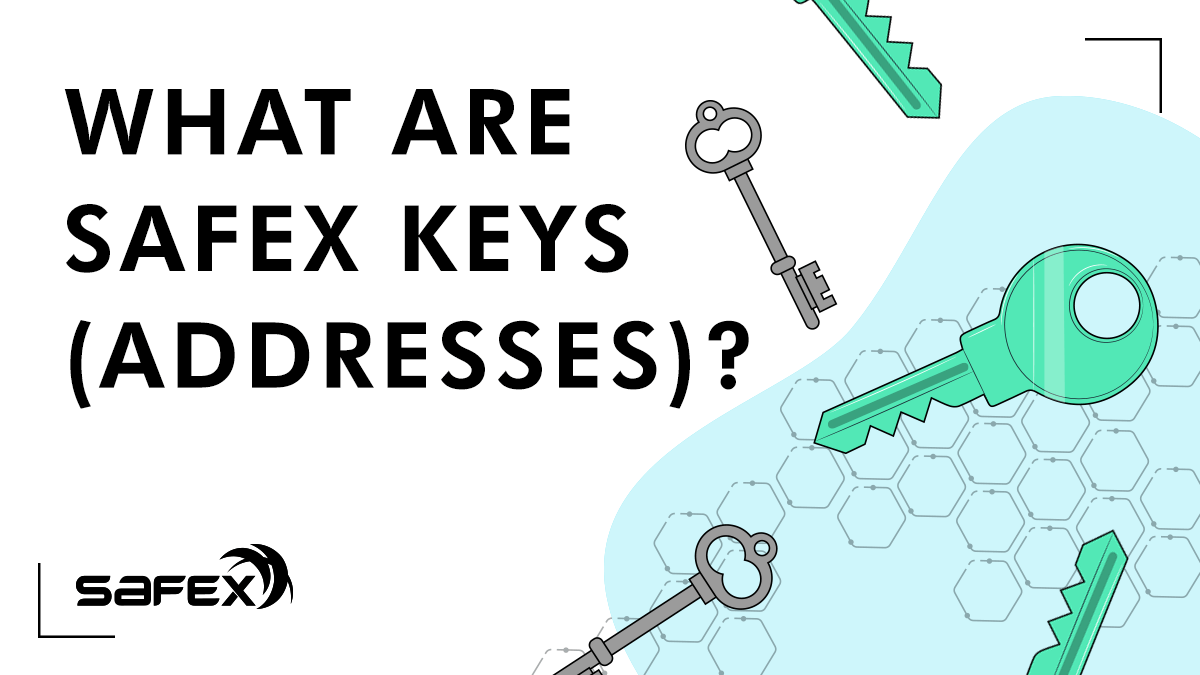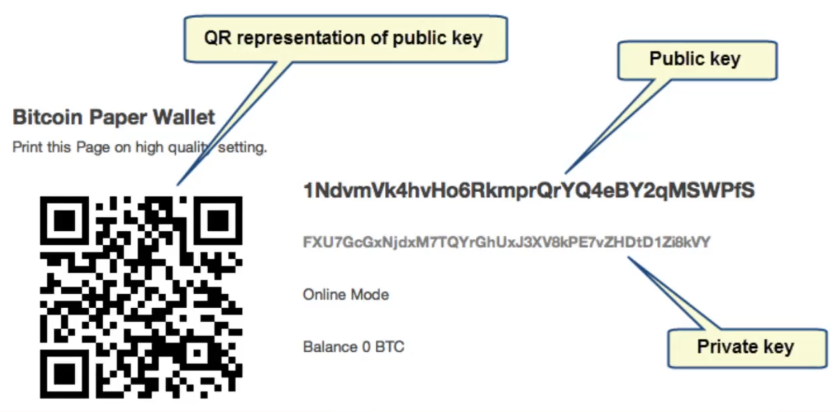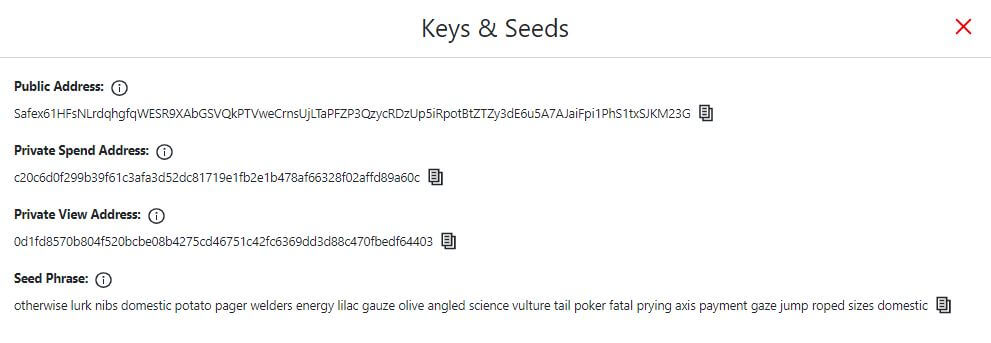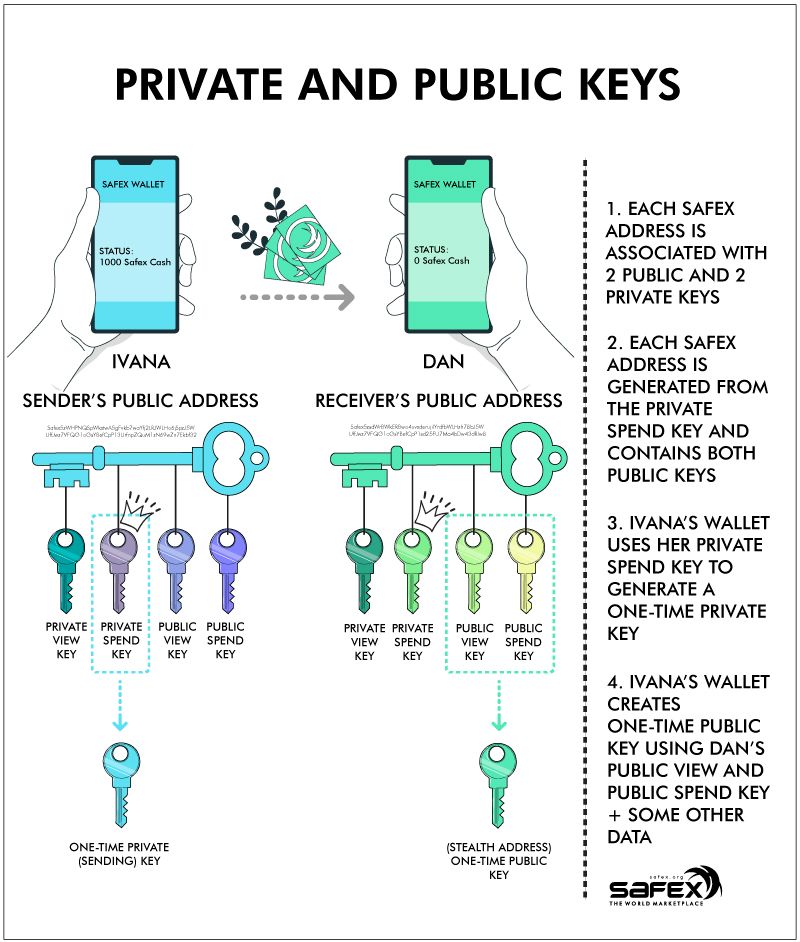What are Safex Keys / Addresses?
Learn about Safex Keys.

The words Public Key, Public Address and Address in the original context of Bitcoin mean the same. Bitcoin and similar cryptocurrencies on transparent blockchains have one Private and one Public Key. It doesn't matter if you say Public Key, Public Address or Address, but the Private Key is not generally referred to as a Private Address. To avoid confusing the two keys, it has become common parlance, and probably safer, to say Public Address and Private Key.
If someone ever asks you to share your private keys, be immediately wary of them - and don't share them!
Let's go simple
Your address - your Public Address - is the address you share with someone when they need to send you coins. Conversely someone else may share their address with you when you have to send them coins. The word Public in it indicates it's meant for public sharing. For relevancy, you could associate this public address with your bank account number - you can give it to anyone to send money to you. We use the word Address because we associate it with Where to Send. Just like the postage system - to send someone a letter, you need their address.
Private Key, on the other hand, is not meant for sharing with anyone. We associate it with some Personal Key that can unlock our funds. Comparison with PIN code is entirely on the spot - you would never give anyone your card PIN code. Why? Because whoever knows your PIN (or Private Key) can become the owner of all of your coins, and no one can return those coins. Private Key is equivalent to the ownership of cryptocurrencies. Your Public Address can be generated/recovered from the Private Key, but not the other way. That's why you shouldn't share your Private Key with anyone and should keep it safe.

So, when someone wants you to send coins, when you want to withdraw coins to your other address from the exchange - you use the Public Key/Public Address. Private Key you don't share with anyone. Instead, you secure them even more by making backups in more places and keep them safe there.
With Safex, it is almost the same...
Safex uses a more advanced system of keys, to allow the privacy functions to work properly - each Safex (public) address is associated with 2 Private Keys and 2 Public Keys.
Once again, Public Address is your public identity for your Safex wallet. The public address is what you provide to someone when they need to send you Safex Tokens and/or Safex Cash, and is also what you use when mining Safex Cash. What is essential to know is that Safex Tokens and Cash are stored on the same address. So, on one Safex Address, you can have a balance of 1000 Tokens and 2000 Cash. Using Safex Wallet, you can send them to another address or receive more at the current address.
Your Safex wallet address will begin with the prefix Safex... and therefore you can't mistake it with some other wallet address of some other coin.
It is completely safe to share your Safex Public Address that you can find at the first page of the Safex Wallet. In fact, it is the ONLY* piece of information about your Safex Wallet that you should ever need to share (*some users may need to share their private view key, under particularly limited circumstances).
Because Safex is a privacy coin blockchain, sharing your public address does not allow any view of your wallet balance or transaction history. That means that by having your Public Address, no one can see the balance on your address nor transaction history.
But there is an important difference
As mentioned above, Safex Addresses are almost the same as Bitcoin Addresses... except Safex has 4 keys. Why? That is because the Safex Blockchain system is made as a privacy blockchain, and the very essence of the philosophy is the encryption of transaction data to protect the user’s privacy, among others. Privacy is made possible through the use of some technical knowhow, using so-called Ring Signatures and One-Time Addresses (aka Stealth Addresses), which, when used with Safex Addresses ensure all the system is private and safe. Therefore, Safex has 2 private keys and 2 public keys.
The Private keys sign the transactions and decrypt transaction data.
The Public Keys verify signatures and encrypt transaction data.
A more detailed explanation of each Key's role:
1) Public View Key
- It comprises part of your Safex Wallet Public Address.
- It is used in combination with the Public Spend Key to create the one-time stealth address when a sending party's wallet creates a transaction to you.
2) Public Spend Key
- It comprises part of your Safex Wallet Public Address.
- It is used in combination with the Public View Key to create the one-time stealth address when a sending party's wallet creates a transaction to you.

3) Private Spend Key
- The most important - from this Key, all other keys (and thus your wallet address) can be regenerated.
- It can also be translated into a mnemonic seed phrase.
- It is used when signing Outgoing transactions from your wallet in that it creates a unique one-time key (and corresponding stealth address) for each outgoing transaction.
- Never share this Key under any circumstances.
4) Private View Key
- It is used to detect incoming transactions to your wallet.
- At a deeper level, it is used to detect and interpret which one-time stealth addresses for processed transactions correspond to the user's public address.
- It can be used to create a View Only wallet (cli wallet only), which only shows a cumulative balance of all incoming transactions for an address (does not show outgoing transactions, and thus the balance may not accurately reflect the true balance of the wallet).
Your Safex Public Address is actually a combination of your Public View Key and your Public Spend Key, along with a network byte identifier (checks you are on Safex Mainnet network) and a checksum value.

However, Public Addresses aren't actually included in any sent transaction - whenever someone sends coins to an intended Public Address, a One-Time Address (aka Stealth Address) is generated from the recipient's Public Address, and the coins get sent to the Stealth Address.

In this way, every transaction has its own unique address that Safex Token/Safex Cash gets sent to, and outside parties are unable to trace back the transaction to the actual public address to which they are received.
When the recipient's wallet checks blocks for incoming transactions, it is able to detect which Stealth Addresses are paired to the owner's actual Public Address (or, more correctly, their view key), and the incoming transaction is thus detected.
Further to that, the sender of the coins doesn't actually use their own Public Address as the sending address either. Rather, the transaction is signed with a one-time spend key created from the sender's Private Spend Key. So not only can't the recipient of the transaction be found from the transaction data but the sender likewise is protected from detection.
Any regular Public Address can be considered a Standard Address. Within the rpc and cli wallets, advanced users can actually create SUBADDRESSES and/or INTEGRATED ADDRESSES that can be used within the umbrella of the STANDARS ADDRESS for various purposes.
Read more similar texts.
